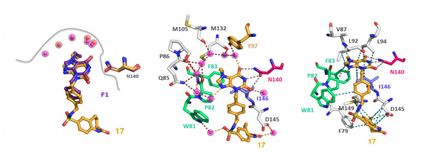Organic chemistry -- leading light waves astray
The development of structured synthetic materials with unusual electromagnetic properties, so-called metamaterials, promises to provide access to special physical effects of great technological interest. Metamaterials have already been fabricated that have a negative refractive index for electromagnetic waves – bending them in the opposite sense to light waves entering water, for instance – which opens up completely novel opportunities for the manipulation of light. One of these makes it possible, in principle, to create cloaking devices that seem to make objects disappear. Indeed, such an invisibility cloak has already been realized for microwaves.
"The production of metamaterials for the manipulation of microwaves presents no special technological challenges – but finding technically feasible ways of controlling the behavior of visible light in a similar fashion is a much more difficult task, because optical wavelengths are much shorter, on the order of half a micron," says Professor Heinz Langhals of the Department of Chemistry at LMU. The first attempts to overcome the technical hurdles depended on the use of elaborate nanotechnological methods that cannot easily be scaled up. However, Langhals and his colleague Alexander Hofer have now synthesized metamaterials based on organic molecules as building blocks. This approach has several advantages over the metallic nanostructures previously used, as the synthetic procedures are more efficient, the components are smaller and their structures can be varied at will. The special geometry required for their metafunction is created entirely by chemical means.
The wrong way round
"We utilize organic compounds with so-called conjugated double-bond systems, which allow the electrons to circulate freely within the molecule," Langhals explains. The necessary electromagnetic resonances arise from the presence in the compound of chromophores, which give the molecule a characteristic color. Chromophores resonantly absorb light in the visible portion of the spectrum. The crucial feature of the newly synthesized molecules is that they contain chromophore electron systems that are arranged in parallel, separated by spacers that permit length-dependent control of interactions between chromophores. This particular spatial configuration alters the refractive properties of the new materials, and in ways that give rise to novel effects. If the sign of the refractive index can be turned negative, light impinging on the material is bent in the opposite direction to light that interacts with a naturally occurring material or medium. "So metamaterials could guide rays of visible light around an object, effectively rendering it invisible," says Langhals.
Although this goal is still some way off, the new organic metamaterials provide the thread from which an invisibility cloak might one day be woven. The fabric itself can perhaps be put together with the help of suitable liquid-crystal structures. At all events, further work on the design of enhanced metamaterials is underway. "Such materials have a broad range of potential uses, and perhaps even more interesting than a simple cloaking function are applications in the area of light-based information technology – the manufacture of ultrathin optical lenses, for instance. We can certainly expect some exciting developments in the future," Langhals concludes.
Original publication
Other news from the department science
Most read news
More news from our other portals
See the theme worlds for related content
Topic world Synthesis
Chemical synthesis is at the heart of modern chemistry and enables the targeted production of molecules with specific properties. By combining starting materials in defined reaction conditions, chemists can create a wide range of compounds, from simple molecules to complex active ingredients.

Topic world Synthesis
Chemical synthesis is at the heart of modern chemistry and enables the targeted production of molecules with specific properties. By combining starting materials in defined reaction conditions, chemists can create a wide range of compounds, from simple molecules to complex active ingredients.





























































